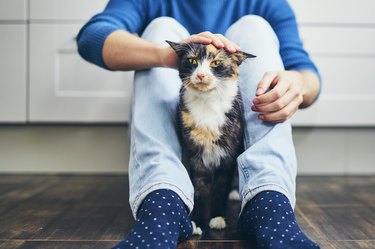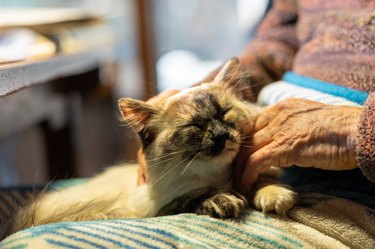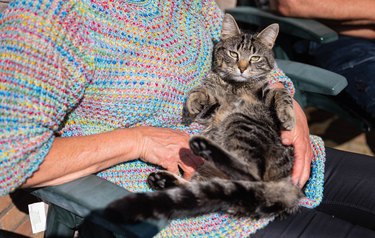Understanding your cat's optimal weight depends on her breed, body type, and overall health. If you can see her ribs and aren't able to feel any fat on her ribs or back, she's likely too thin. An underweight cat should see the vet to ensure she doesn't have a medical condition behind her lightweight frame.

Video of the Day
Is a skinny cat too skinny?
Much emphasis is placed on the dangers of carrying excessive weight — joint disorders, diabetes, and shorter life span are among the health risks associated with obesity. However, underweight cats are also more susceptible to injury and illness.
Video of the Day
In long-haired breeds, skinny cats can often go unnoticed. You might not realize your feline is wasting away (unless you notice she's not eating, or her coat becomes dull and harsh). In the case of hyperthyroidism, on the other hand, your cat will be eating a lot.
Although some cats are very finicky, others could have a hard time eating due to dental issues, pain, or other physical conditions not readily seen. Stress, anxiety, or changes such as a move, new pet, or remodeling the house could also cause your kitty to go off her feed.
Take notice of any changes you see in your cat's behavior, including how she eats. For example: does she gulp down dry kibble without chewing? Does she chew on one side of her mouth? Does food fall out of her mouth while she's eating? If so, these habits might indicate underlying health issues like dental pain that contribute to how much or how little your cat eats.
Be familiar with how much your cat should weigh. A Maine coon, for example, tips the scales at 10 to 25 pounds while a Siamese can be perfectly healthy at just 5 pounds (though 7 pounds is a more likely low end), according to the Association for Pet Obesity Prevention. Occasionally jot down how much your cat weighs so you have a record over time. Was she 8 pounds a year ago but now she's 6 pounds? For many cats, this drop in weight is a cause for concern.

Understand cat body type
Cats come in 6 different shapes and sizes, including oriental, foreign, semi-foreign, semi-cobby, cobby, and substantial. These shapes range between the extremes of two different body types or conformations: Oriental and substantial.
Most mixed-breed domestic short-hair cats are a combination of two of the two body types, Oriental and cobby. Characteristics of the Oriental build include
- svelte and fine-boned
- long, slender limbs
- slender, pointed tails
- and long, triangular heads
Traits of a substantial build include
- heavy-boned
- large-bodied, and
- long, fluffy tails
As cats vary according to build, they also differ in appropriate weight ranges. The Siamese, with her Oriental build, typically weighs between 7 and 10 pounds. The Persian has a cobby build and usually runs between 7 and 12 pounds. A mixed-breed cat typically weighs around 8 to 10 pounds. Some cats are built more substantial, such as the Maine coon, who runs between 10 and 25 pounds. As the name might suggest, a substantial cat is not short or round bodied like a cobby cat. The Norwegian forest cat is substantial, and is also one of the largest domesticated cat breeds in the world.

Size up your cat
It's pretty easy to look at your cat and tell if she's at her ideal weight. Stand above her and take a good look at her. Visible signs a cat is underweight are:
- Very narrow waist
- Prominent rib cage
- Obvious shoulder blades
- Visible spine and ribs
If your cat has a long coat, it may be difficult to check her weight visibly; use your hands to gauge her weight. Stand behind her and spread your fingers over her ribs, while lightly pressing your thumbs on her spine. As you gently rub along her sides, you may feel indications she's underweight, such as:
- Lack of fat on her back or ribs
- Easily distinguished ribs and spine bones
A cat who is of proper weight should have a minimal fat covering on her back and ribs.
Get professional advice
If your cat is too skinny, she should see the veterinarian. There are a host of medical conditions that can cause weight loss and wasting in cats, including:
- Hyperthyroidism — other symptoms include ravenous appetite, vomiting, diarrhea, and increased meowing, especially at night
- Diabetes — also accompanied by drinking and urinating excessively
- Cancer — common signs include lethargy, appetite loss, and hiding behavior
- Gastrointestinal illness — to include diarrhea, vomiting and appetite loss
- Dental issues — often accompanied by loss of appetite, drooling, or gulping down food without chewing
- Kidney issues — common signs are poor coat quality and drinking and urinating more
Organ failure, intestinal parasites, and feline infectious peritonitis also can cause weight loss. Additionally, a cat who's experiencing stress such as anxiety or depression can drop weight and become too thin.
A cat who loses too much weight, especially too quickly over a period of 3 to 4 days, is also vulnerable to feline hepatic lipidosis. This is a potentially fatal condition. The whole body is using the fat for energy. And as that occurs, the liver becomes unable to process it all. The fat then ends up getting stored in and around the liver. This build-up of fat further compromises it's ability to function. Hepatic lipidosis is more likely to occur in cats who are overweight.